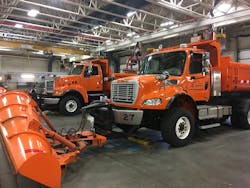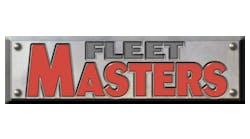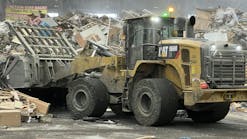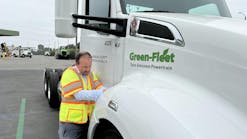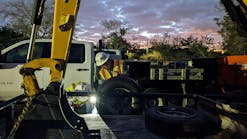Combining 16 county entities with their own fleet-management functions and budgets into one Fleet Management department took years of work and a lot of communication, says Kevin Schlangen, CEM, CPFP, CAFM, fleet manager for Dakota County (Minn.) Fleet Management.
But Schlangen and his veteran team were up to the task, and today the county’s singular fleet operation runs like a well-oiled machine despite a hugely diverse fleet and wide-ranging county needs.
Dakota County (Minn.) Fleet Management is the medium-fleet winner of the 2017 Fleet Masters Award.
Dakota County’s fleet includes not only the requisite yellow iron, but also snowmobiles, snowplows, boats, pickup trucks, law enforcement vehicles, mowers, chainsaws, and even a custom-made water rescue trailer to house diving equipment.
Schlangen started his career with the county in 1990 as fleet manager for the transportation department, which did not hold the majority of the county’s equipment assets yet accounted for 70 percent of the county’s fleet value. Transportation had programs in place to measure costs, track maintenance and utilization, and manage equipment life cycles with an eye on making the proper replacement decision. The other 15 departments? Not so much.
Combining county departments’ fleet operations into one Fleet Management entity had been discussed and dismissed on and off by the county’s elected officials and fleet stakeholders.
“Groups initially weren’t willing to give up control,” Schlangen says. “Internally, the county had said it would be a good thing, but they didn’t do it. Then a consultant came in and said the same thing. There was even a study on whether or not they [the county] should merge groups.
“The study recommended everyone follow Transportation; we were already tracking all the information and doing all the things they said should be rolled out across the entire county,” Schlangen says.
Under one Fleet Management group, however, the other 15 departments would lose more than control; their capital budgets would roll into Fleet. It took many meetings with fleet stakeholders, but Schlangen and his team eventually convinced the departments of the advantages of Fleet Management. “We assured them we would continue accepting input from the user groups and elected officials,” Schlangen says, “but everybody lost all their budgets—the money was physically removed from their budgets.”
The hardest part of the consolidation was not the implementation of Transportation’s existing programs, but communication.
“It was communication and understanding about the goals of what we were looking for in professional fleet management,” Schlangen says. “As a general rule, everybody owns a vehicle, so everyone’s a fleet manager because they have a car. They ask, ‘How difficult is it?’ But in a mixed government fleet like we have, it’s a huge challenge because you swear you have one of everything. You’ve got such a bag of different things. You can work on snowmobiles, ATVs, law enforcement vehicles, and trailers at the same time.
“We have 50 different classifications, just not as many of some of them. Finding all the equipment we had was a little shocking to county senior management, as far as finding what we really had versus what the different groups said they had. The records were off by hundreds of pieces of equipment,” he says. “They would replace something and not sell the other one.”
Schlangen also found that costs weren’t being tracked and replacement decisions weren’t driven by data—for $23 million worth of equipment. “Groups looked to replace equipment without reason or a rational ‘why,’” Schlangen says. “We had always used a point system in Transportation. When we talked to the county about replacement of equipment, we followed a criteria. Instead of a huge explanation for officials and user groups, it came down to one simple report. We showed them this is how we’re going to apply it to replacement. It’s a business decision, not a feeling.”
Fleet Management now assigns points based on seven factors that include age, miles or hours, type of service, reliability, maintenance and repair costs, condition, and energy efficiency. The county has roughly 700 pieces of equipment, but can only use the points system on 307. “We can’t exactly apply it to weed trimmers and chainsaws, or trailers,” Schlangen says. “But in a $23 million fleet, that 307 is 85 percent of the value of our fleet.”
Schlangen also worked to right-size the fleet, eliminating 125 units and saving $2.7 million in the last five years. “Now as we buy, we have those key discussions. Can it be used across departments? We can make better decisions so assets are better utilized, like can a tractor be used in both summer and winter, with maybe a change of attachments, instead of requiring two tractors with different attachments?” he says.
These days, what stands out for the county isn’t the procedures that don’t exist, but instead how smoothly Fleet Management operates. They use computerized fleet analysis software, first introduced in Transportation, where Schlangen had been using various versions since 1993. He’s also a big believer in telematics.
“Everything on-road has full telematics. We went heavily into driver behavior and idle time,” Schlangen says. Fuel use and efficiency, however, is not tracked by telematics, yet the county measures fuel religiously from its six fuel islands and has made major gains through changes in its vehicle pool.
“When we started, basically every pickup we had was a three-quarter-ton pickup,” Schlangen says. “Well, you don’t need a three-quarter-ton pickup to do inspections. You just need four-wheel drive. And not everyone needs to tow or haul something. A park ranger doesn’t need a large SUV to patrol county parks. Now, we’ve put them in Fusion hybrids and compact pickups.
“These moves may not have saved as much in right-sizing, but the operational savings as far as the cost of maintenance, repairs, and fuel has been huge,” Schlangen says. The county also has purchased a number of electric vehicles such as Chevy Volts and Toyota Priuses.
Between 2005 and 2015, Fleet Management improved its miles-per-gallon statistics by 31 percent. It also reduced greenhouse gas emissions by 34 percent in that time period. The numbers are verified by the NAFA Sustainable Fleet Accreditation program, which is administered by CALSTART.
Impressive results—from a combination of factors.
